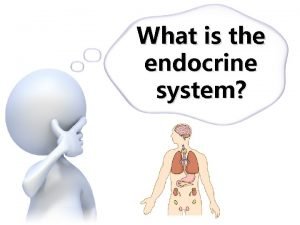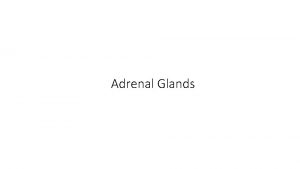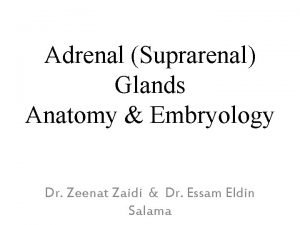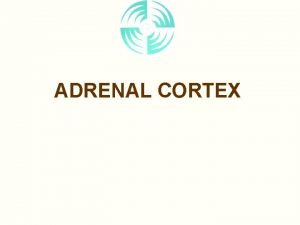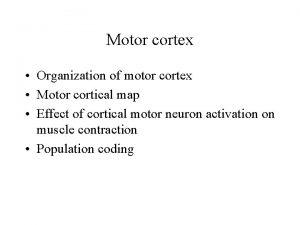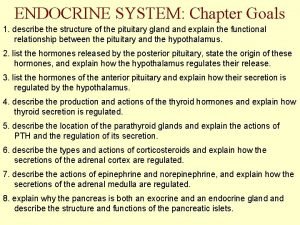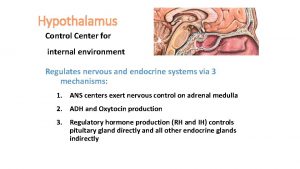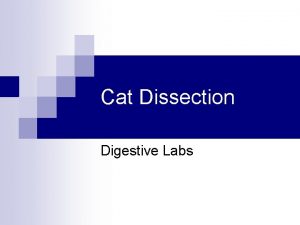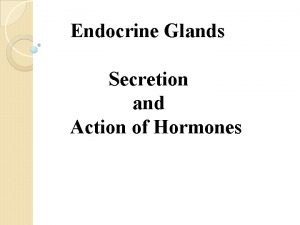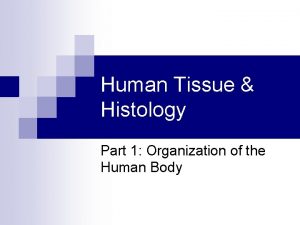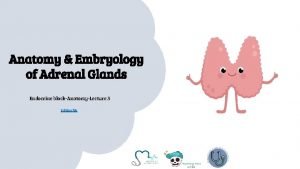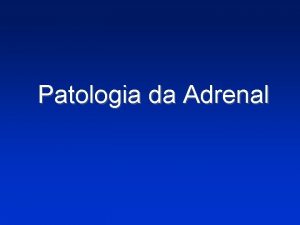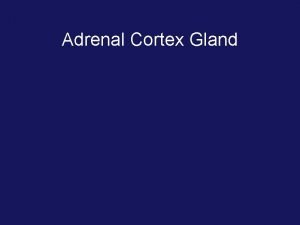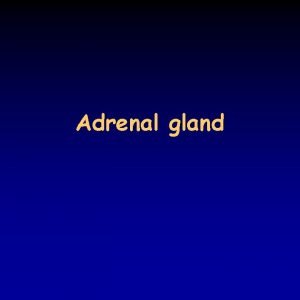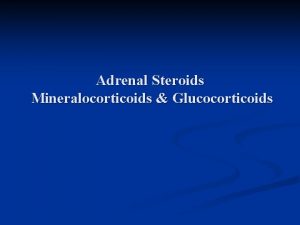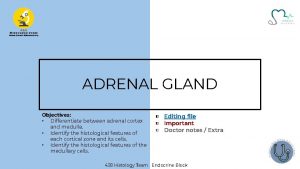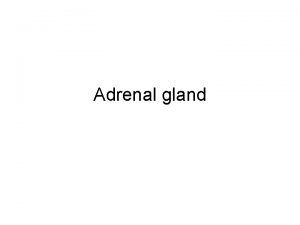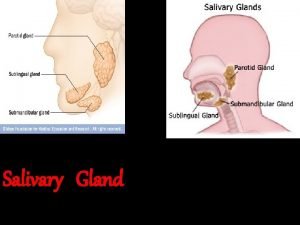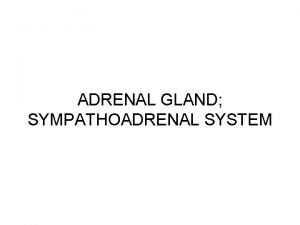Adrenal gland Hormones of the adrenal cortex the











- Slides: 11

Adrenal gland

Hormones of the adrenal cortex • the paired adrenal glands (4 -5 g each) are located at the upper pole of the kidneys embedded in adipose tissue • medulla: adrenalin (80%) and noradrenalin (20%) • cortex: – zona glomerulosa, outmost layer (5%): mineralocorticoids – zona fasciculata: mostly glucocorticoids, but also androgens – zona reticularis: mostly androgens, but also glucocorticoids • androgen (dehydroepiandrosterone, DHEA) secretion starts at the age of 5 (adrenarche), decrease after 40 -50 • transformed to testosterone and dihydrotestosterone at the periphery; main source of androgens in females • overproduction of POMC increases androgen secretion 2/9

Glucocorticoids 3/9 • diverse effects: adjustments to fasting, effects on nervous system, inflammation, healing of wounds, growth • in humans cortisol, in rats corticosterone is the most important • cortisol has 21 C atoms similarly to aldosterone, but the latter has an additional aldehyde group • they bind to intracellular plasma receptors: – type I receptor (kidney distal tubule, colon, secretory duct in salivary glands: similar affinity for mineralo-, and glucocorticoids, but the latter hormones are degraded quickly by the cells – type II receptor (liver cell, muscle cell, lymphocyte): much stronger affinity for glucocorticoids • synthetic steroids: tissue-dependent effect is possible – medicines!

Glucocorticoid effects I. 4/9 • glucocorticoids are transported in the blood coupled to transport proteins – transcortin (corticosteroid-binding globulin), but might be coupled to albumin as well (aldosterone is transported mostly by albumin) • adjustment to fasting – permissive: enables appropriate level of enzymes activated by hormones produced during fasting (glucagon, adrenalin) • but: cortisol level does not increase during fasting – gluconeogenesis • protein synthesis decreases in muscles – more amino acids are available • level of enzymes needed for gluconeogenesis increases in the liver, c. AMP (increased by glucagon, adrenalin) activates these – c. AMP itself is ineffective – decreased glucose uptake in muscle and adipose cells – lipolysis – glucocorticoids are needed for the effect of hormones increasing lipolysis, decrease of glucose uptake itself has also lipolytic effect

Glucocorticoid effects II. 5/9 • CNS effects – differential receptor distribution in the brain –high level in hippocampus – malfunctioning might be caused by both too low and too high levels: depression, disturbances of sleepwake cycle, etc. – drastic lowering of cholesterol level – depression • anti-inflammatory effect – occurring at high doses, physiological effect? – various noxious effects cause inflammation with classic symptoms: rubor, calor, dolor, tumor – release and accumulation of paracrine inflammatory mediators, positive feedback: kinins (e. g. bradykinin), cytokines (e. g. interleukins, interferon), eicosanoids (produced from arachidonic acid – e. g. prostaglandins, leukotrienes), histamine – cortisol inhibits their production in several ways – lymphocytes disintegrate in rats, leave the vessels in humans – cortisol inhibits proliferation

Regulation of secretion 6/9 • CRH-ACTH-adrenal gland axis • ACTH is needed for the survival of z. fasciculata and reticularis • cortisol synthesis and secretion follows faithfully ACTH pulses, but with a delay of a few minutes • synthesis starts from cholesterol esters stored in intracellular lipid droplets, from LDL taken up from blood, end from cholesterol synthesized de novo • ACTH stimulates cortisol production through c. AMP • fast effect: cleavage of cholesterol ester, facilitation of LDL uptake, speeding up cleavage of cholesterol side-chain, transport into mitochondria • slower effect: increased synthesis of these enzymes, receptors, transporters at the level of transcription

ACTH Regulation of cortisol release ATP LDL-receptor endocytosis c. AMP cholesterol lipid droplets, storing cholesterol in the form of cholesterol LDL lisosome cortisol 7/9

Stress • Selye described in rats in the 30’s the „alarm reaction” induced by harmful stimuli • common symptoms: enlargement of adrenal cortex, shrinkage of lymphoid glands (thymus) – the latter does not occur in humans • stress – stressor • process started by the nervous system – CRH – ACTH – glucocorticoids • if this chain is broken, or glucocorticoid receptors are missing, weak stress (e. g. bleeding) can be lethal • mechanism is unknown, limitation of cytokinin release is a possibility • in stress there is a considerable increase in the arginnin-vasopressin release from small neurosecretory neurons – it increases ACTH release in synergy with CRH, but is less sensitive to feedback from glucocorticoids 8/9

Malfunctioning of adrenal cortex • lesion of the adrenal cortex (over 90%) – Addison’s disease – usually autoimmun reaction – hypoglycaemia, low resistance against stress, hypodynamia – due to lack of cortisol – sodium loss, potassium retention – due to lack of aldosteron – hypopolarization of heart muscle, decrease of blood volume – overproduction of POMC – melanocyte stimulating effect – darkening of the skin (tanning) – in females loss of body hair and libido due to lack of androgen hormons • overproduction of glucocorticoids – Cushing’s disease • CRH, ACTH or cortisol overproduction, sometimes for iatrogen causes – shrinkage of muscles, lypolysis on extremities and in subcutis, fat deposition on the head, neck and trunck region (causes? ) – sometimes androgen overproduction - virilism 9/9

End of text

Anatomy of the adrenal cortex connective tissue capsule medulla connective tissue capsule zona glomerulosa zona fasciculata cortex zona reticularis medulla Fonyó: Orvosi Élettan, Medicina, Budapest, 1997, Fig. 32 -1.
